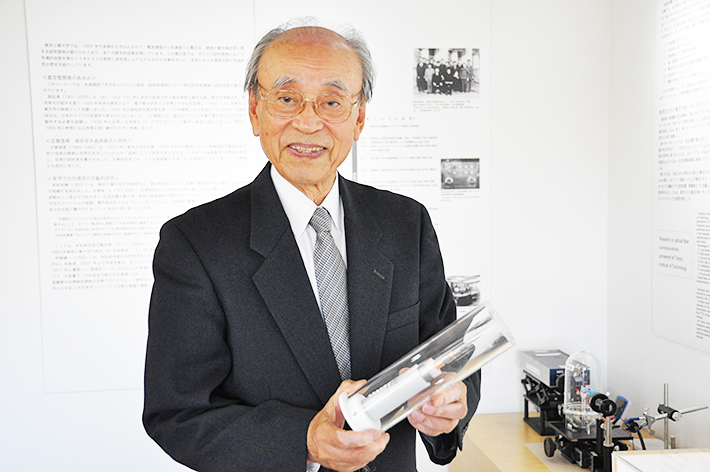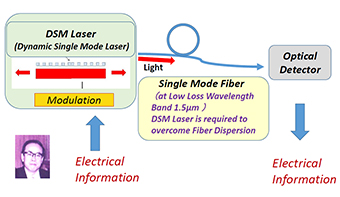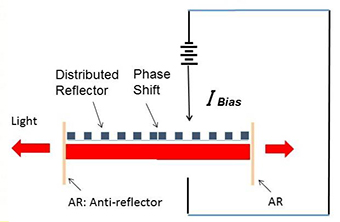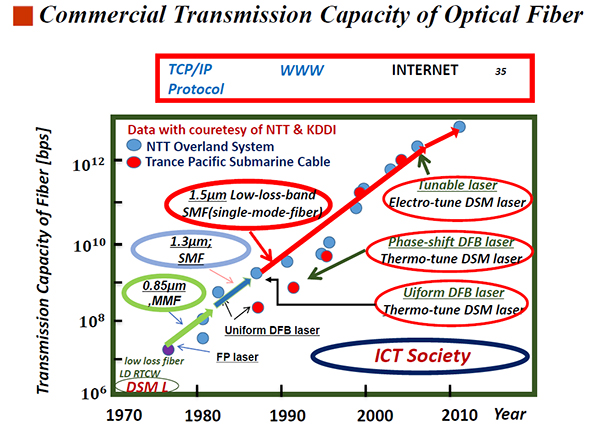Honorary Professor and Former President Yasuharu Suematsu has been awarded the 2015 Order of Culture. The Order of Culture is an order bestowed on those who have made preeminent contributions to the development of culture, including in the arts, science and technology.

Honorary Professor and Former President Yasuharu Suematsu
Honorary Professor Yasuharu Suematsu excelled in the field of optical communications, creating the dynamic single mode laser (DSM laser) — a laser which emits light in a wavelength range of minimum transmission loss and maintains a stable wavelength even with high-speed light modulation. His outstanding achievements include playing a major role in establishing the high-capacity and long-distance optical fiber communication system that supports today's Internet society. He has contributed much to the advancement of this discipline as well to the development of this industry.
Comment from Honorary Professor Yasuharu Suematsu
It is such a privilege to be joining the ranks of those masters who received this honor before me.
I would like to take this opportunity to reflect on all that I am truly grateful for — the mentors who gave me guidance; the classics through which I gained the wisdom of humanity; the fortune to have been born during such a revolutionary time; the research funds that supported my work; my pupils who made vital contributions each step of the way; my colleagues who I was able to work with in constructive rivalry; my health which allowed me to take an active role in this field; my family, including my parents, siblings, wife, and children; and our society which nurtures culture and passes it on as we move forward together.
Summary of research

Figure 1.
Optical Communication with Single Mode Fiber
and Dynamic Single Mode Lasers (DSM Laser)
Light is the highest frequency of electromagnetic waves that humans can control. It outperforms radio waves by a wide margin in transmitting a large capacity of information. Research into optical communications was undertaken in countries such as Japan, the United States, and the United Kingdom. The nature of optical fiber communication was recognized as possibly being able to transmit a large capacity of information over a long distance, all over the world. To make it a reality, the focus was on creating a DSM laser which has the following three characteristics:
- 1.
- Operates at a wavelength band which causes minimal loss within the optical fiber to allow for long-distance transmission (1.5 micrometers was discovered to be the ideal wavelength band during the course of research)
- 2.
- Operates stably at a single wavelength to surmount the problem of transmission capacity reduction due to dispersion on the propagation constant in single mode optical fibers
- 3.
- Allows the wavelength to be tuned to adapt to communication in multiple wavelengths

Figure 2.
Phase-shift distributed feedback laser
— a thermo-tunable DSM laser
First, we pioneered materials for a mixed crystal of GaInAsP/InP for a semiconductor laser that would operate at a wavelength band of 1.5 micrometers, which causes minimal loss inside the optical fiber, and continuously operates at room temperature. During this time, we proposed a single mode resonator which consists of two distributed reflectors joined together with a phase shift by odd numbers of half pi. We also succeeded in creating an integrated laser which was capable of integrating lasers and optical circuits monolithically. Following these preliminary achievements, in 1980, we succeeded in creating an integrated laser with built-in distributed reflectors using a material in the band of 1.5 micrometers. We built a DSM laser that stably operates at a single mode even under rapid direct modulation, and continuously operates at room temperature. This laser remained in stable operation mode even when the temperature was changed, so we could tune the wavelength thermally. Thus, the thermo-tunable DSM laser was born. Meanwhile, research and development progressed at industries in areas such as optical fibers, optical circuits, optical devices, modulation schemes, system structures. The actualization of the DSM laser became an impetus to develop high-capacity and long-distance optical fiber communications, and it began to be applied commercially in the late 1980s.
Among these, the phase-shift distributed feedback laser that we proposed in 1974 and demonstrated in 1983 is a thermo-tunable DSM laser which had a high rate of production yield. Since the beginning of the 1990s, it had been consistently and widely used commercially as a standard laser for long-distance use, giving me a measure of relief. On the other hand, the electro-tunable DSM laser, which I felt would be the final form, is, so called, a wavelength tunable laser that we proposed in 1980 and demonstrated in 1983. It was a long time before this laser was used commercially. It was around 2004 that, through the efforts of those involved, this wavelength tunable laser was developed and used commercially in dense wavelength division multiplexing systems. It became utilized in earnest around 2010. I became aware of this recently, about three or four years ago. I was finally able to become satisfied with my work.
Another thing I want to mention is the semiconductor laser called VCSEL, developed by former Tokyo Tech President Kenichi Iga in 1988. This laser, also, under suitable specifications, becomes a DSM laser. Its low-power operation is a distinguishing factor. It complements the long-distance communication of the aforementioned research, and is widely used for short-and-middle-distance optical fiber communications, domestically and internationally.
Impact on society
High-capacity and long-distance optical communications in the lowest loss wavelength band of 1.5 micrometers use DSM lasers as their light source, and have progressed along with research and development of optical fiber, optical devices, modulation schemes, and the like. Thermo-tunable DSM lasers developed by this research have been commercially applied for long distances, for overland trunk systems (1987) and for intercontinental submarine cables (1992), and continue to support the progress of the Internet to this day. Additionally, since around 2004, electro-tunable DSM lasers (wavelength tunable lasers) are being used as the light source to advance dense wavelength division multiplexing systems and for coherent communications.

Figure 3. Secular increase of optical fiber transmission capacity
Today, optical fiber communications make up a highly dense communications network circling the globe tens of thousands of times, and are also used in applications such as middle-distance Ethernets. Additionally, DSM lasers in the band of 1.5 micrometers are used for optical lines from the exchange center to the home in FTTH.
In such ways, the information transmission capability of optical fiber has reached several hundred thousand times as much as the coaxial cables preceding them, and have significantly lowered the cost of transmitting information. Reflecting this, the mid-1990s saw the network industry such as Yahoo, Google and Rakuten appear one after the other. Optical fiber communications has progressed and the Internet has developed, and instantaneous transmission of a large volume of knowledge is now a daily occurrence. In the electrical communication era of the 1960's, large volumes of data, such as documents on which civilization rests, were circulated slowly in forms such as books. In contrast, the proliferation of high-capacity and long-distance optical fiber communications has allowed for large-volume information such as books to become used interactively in an instant. The research of optical fiber communications contributed to the rapid transition to a civilization based on information and communications technology.
Profile
- 1960
Tokyo Institute of Technology, Doctor of Engineering
- 1961
Associate Professor, Tokyo Institute of Technology
- 1973
Professor, Tokyo Institute of Technology
- 1989
President, Tokyo Institute of Technology
- 1994
Member, Space Activity Commission
- 1997
Member, Science Council of Japan
- 1997
President, Kochi University of Technology
- 2001
Director General, National Institute of Informatics
- 2005
Advisor, National Institute of Informatics
- 2009
Advisor, Kochi University of Technology
- 2010
Chairperson, Takayanai Kenjiro Foundation
- 2011
Honorary Professor, Tokyo Institute of Technology
- 2012
Chairperson, Hoso Bunka Foundation
Major Awards
- 1983
Valdemar Poulsen Gold Medal (Denmark)
- 1985
Electronics Letters Premium Award (IEE, UK)
- 1986
David Sarnoff Award (IEEE)
- 1989
Toray Science and Technology Prize
- 1993
John Tyndall Award (IEEE/OSA)
- 1994
NEC C&C Prize
- 1994
Broadcast Culture Prize (NHK)
- 1996
Medal with Purple Ribbon
- 1997
Eduard Rhein Prize (Germany)
- 2003
Person of Cultural Merit
- 2003
IEEE Education Medal (IEEE)
- 2005
Nakatsugawa City Honorary Citizen
- 2006
The Order of the Sacred Treasure, Gold and Silver Star
- 2006
Okawa Prize
- 2014
Tokai Television Culture Prize
- 2014
Japan Prize
- 2015
The Order of Culture
. Any information published on this site will be valid in relation to Science Tokyo.






